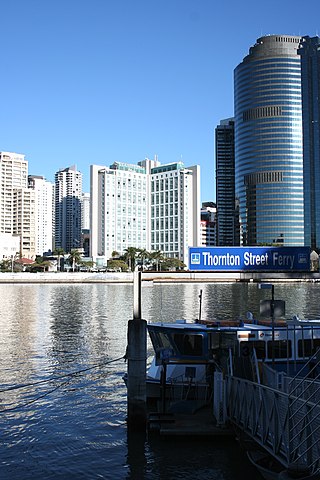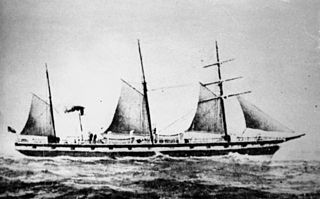
The capsize of the ferry Pearl occurred on Thursday 13 February 1896 in the Brisbane River, Queensland, Australia. It was estimated that half of the 80-100 people on board the ferry died. [1]

The capsize of the ferry Pearl occurred on Thursday 13 February 1896 in the Brisbane River, Queensland, Australia. It was estimated that half of the 80-100 people on board the ferry died. [1]
The ferry was in use as a temporary measure due to the loss of both bridges that crossed the river, the Victoria Bridge and the Albert Railway Bridge, at Indooroopilly [2] after the floods of 1893. Steamers like Pearl were then commissioned to transfer traffic across the river between Brisbane’s Queen’s Wharf and Musgrave Wharf.
The ferry was described as such:
The Pearl was a wooden screw-steamer of ten horse-power and forty-one tons register, gross. Her dimensions were: 58.7ft long, 15.1ft beam, and 5.1ft depth, and she was built in New South Wales in 1883. She had been engaged in the river trade, and between Brisbane and Redland Bay, and was formerly running between Brisbane and Humpybong. The vessel was built with an upper and lower deck, and was licensed to carry about 120 passengers in the river. [3]
On the afternoon of the disaster, at around 5pm, Pearl was re-crossing the river, which was flowing more strongly than usual due to floodwaters. To avoid a collision with another ship, Normanby, the captain cut power but the ferry was pushed downriver into the anchor chain of Lucinda , a government steam yacht anchored mid-river.
The hull breached and the ferry quickly capsized, drowning those below deck and throwing those on deck into the water, resulting in the death of many of the 80-100 people believed to be on board. [4]
Nearby small boats, including those from other ferries and one from Lucinda, raced to the site and rescued around 40 survivors, some of whom clung to the anchor chain, life buoys, or wreckage.
In order to salvage bodies, diving operations were also undertaken in the river. [5] Others retrieved bodies down river in the following weeks. The ship was later raised from the river on 6 March 1896. [5]
An inquest was later held into the accident with blame focusing on the captain, James Chard (who survived), who may have been drinking. [4] [6] Chard had his certificates and licences to pilot steamers cancelled following the inquest. [5]

The Brisbane River is the longest river in South East Queensland, Australia, and flows through the city of Brisbane, before emptying into Moreton Bay on the Coral Sea. John Oxley, the first European to explore the river, named it after the Governor of New South Wales, Sir Thomas Brisbane in 1823. The penal colony of Moreton Bay later adopted the same name, eventually becoming the present city of Brisbane. The river is a tidal estuary and the water is brackish from its mouth through the majority of the Brisbane metropolitan area westward to the Mount Crosby Weir. The river is wide and navigable throughout the Brisbane metropolitan area.

The Victoria Bridge is a bus and pedestrian bridge over the Brisbane River. The current bridge, opened in 1969, is the third permanent crossing erected at this location. Since 24 January 2021, the bridge has been closed to general traffic, and now carries buses, pedestrians and cyclists only.

Albert Bridge is a heritage-listed railway bridge of steel truss design crossing the Brisbane River between Indooroopilly and Chelmer in the City of Brisbane, Queensland, Australia. It was designed by Henry Charles Stanley and built from 1894 to 1895 by John McCormick & Son as a replacement for an earlier bridge lost to flooding in 1893. Both bridges were named in honour of the Prince of Wales, Prince Albert. It was added to the Queensland Heritage Register on 21 October 1992.

MS Herald of Free Enterprise was a roll-on/roll-off (RORO) ferry which capsized moments after leaving the Belgian port of Zeebrugge on the night of 6 March 1987, killing 193 passengers and crew.

Kangaroo Point is an inner southern suburb in the City of Brisbane, Queensland, Australia. In the 2016 census, Kangaroo Point had a population of 8,063 people.

Brisbane City is the central suburb and central business district of Brisbane, the state capital of Queensland, Australia. It is colloquially referred to as the "Brisbane CBD" or "the city". It is located on a point on the northern bank of the Brisbane River, historically known as Meanjin, Mianjin or Meeanjin in the local Aboriginal Australian dialect. The triangular shaped area is bounded by the median of the Brisbane River to the east, south and west. The point, known at its tip as Gardens Point, slopes upward to the north-west where the city is bounded by parkland and the inner city suburb of Spring Hill to the north. The CBD is bounded to the north-east by the suburb of Fortitude Valley. To the west the CBD is bounded by Petrie Terrace, which in 2010 was reinstated as a suburb.

Holman Street ferry wharf is a heritage-listed ferry wharf located on the southern side of the Brisbane River in Kangaroo Point, City of Brisbane, Queensland, Australia. It is served by RiverCity Ferries' CityHopper and the Cross River service to Riverside wharf. It was added to the Queensland Heritage Register in 2004.

QUT Gardens Point ferry wharf is a CityCat terminal located on the northern side of the Brisbane River serving the Brisbane central business district in Queensland, Australia. It is operated by RiverCity Ferries on behalf of Brisbane City Council.

South Bank ferry wharf is located on the southern side of the Brisbane River serving the Brisbane suburb of South Brisbane in Queensland, Australia. The wharf is used by RiverCity Ferries CityCat and CityHopper services.

UQ St Lucia ferry wharf is located on the southern side of the Brisbane River serving the Brisbane suburb of St Lucia in Queensland, Australia. It is served by RiverCity Ferries' CityCat services.

The article Ferry transport in Queensland provides both historical and current information relating to scheduled public passenger ferry services in Queensland. The first ferry started on 1 January 1843 at Russell Street with a service across the Brisbane River.

The Lucinda was a Queensland Government owned, 301-ton paddle steamer built by William Denny and Brothers, Dumbarton, Scotland in 1884.

SS Gothenburg was an iron-hulled sail- and steamship that was built in England in 1854 and sailed between England and Sweden until 1862. She then moved to Australia, where she operated across the Tasman Sea to and from New Zealand until 1873, when she was rebuilt. After her rebuild, she operated in the Australian coastal trade.

The Greycliffe disaster occurred in Sydney Harbour (Australia) on 3 November 1927 when the harbour ferry Greycliffe and the Union Steamship Company mail steamer Tahiti collided. The smaller ferry was cut in two and sank with the loss of 40 lives, the deadliest incident on Sydney Harbour.

Howard Smith Wharves is a heritage-listed wharf on the Brisbane River at Boundary Street, Brisbane City and Fortitude Valley, City of Brisbane, Queensland, Australia. It was built from 1939 to 1942. It is also known as Brisbane Central Wharves. The 3.5-hectare (8.6-acre) site is one of the most culturally and historically significant riverfront locations in Brisbane. It was added to the Queensland Heritage Register on 4 February 1997.

Hamilton Reach is a reach of the Brisbane River in Brisbane, Queensland, Australia.

Kirawa was a ferry on Sydney Harbour. She was a near identical sister vessel with Kanangra both of which were launched in 1912 during the early-twentieth pre-Sydney Harbour Bridge boom years of Sydney Ferries Limited.
The Kalara was an iron paddle steamer built in 1881 by Smith, Forrester, and Co., and launched at Kangaroo Point for Messrs. D. L. Brown and Co. It ran regular trips between Brisbane and the Tweed River. On Saturday 6 November 1886 the Kalara whist exiting the tweed river ran over its own anchor and pierced its hull causing it to sink approximately 30 minutes later approximately one mile north-east of Point Danger and from the Tweed River bar in 15 fathoms.

The ferry Rodney capsized and sank on Sydney Harbour 13 February 1938 with the loss of 19 lives. The ferry was carrying well-wishers and girlfriends of sailors on the heavy cruiser USS Louisville as it left the Harbour.

Sydney Harbour ferry services date back to the first years of Sydney's European settlement. Slow and sporadic boats ran along the Parramatta River from Sydney to Parramatta and served the agricultural settlements in between. By the mid-1830s, speculative ventures established regular services. From the late-nineteenth century the North Shore developed rapidly. A rail connection to Milsons Point took alighting ferry passengers up the North Shore line to Hornsby, New South Wales via North Sydney. Without a bridge connection, increasingly large fleets of steamers serviced the cross harbour routes and in the early twentieth century, Sydney Ferries Limited was the largest ferry operator in the world.